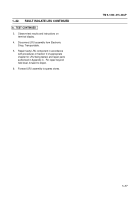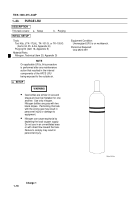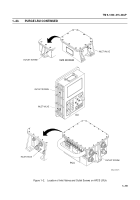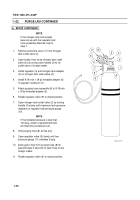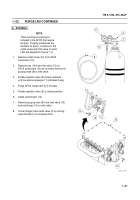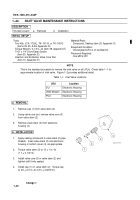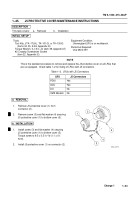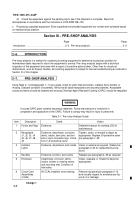TM-9-1200-215-34-P - Page 39 of 266
TM 9–1200–215–34&P
2–4
b.
During operation, the ACU receives projectile type, propellant charge, relative target location, and
miscellaneous information from other AFCS and navigation components, via a 1553B bus. Ballistic processing is
accomplished by using equations of motion. Sheaf processing algorithms, compatible with those used by the
Battery Computer System (BCS), are used to compute aimpoint offsets. Computed solutions are sent to the ACU
weapons controller to implement valid 155mm projectile/fuze/charge combinations. The weapons controller will
automatically lay the weapon to the determined azimuth and elevation when the GUN SERVO switch on the
Display Unit (DU) is activated. In addition to weapon control function, the ACU interfaces with a gun tube
mounted temperature sensor. The ACU interprets temperature data and then monitors the status of the gun tube
temperature. The block diagram shown in figure 2–1 illustrates the principal ACU signal flows during operation.
c.
The ACU consists of a single, sealed, enclosed housing and the following components:
D
Power Supply Assembly
D
Central Processing Unit (CPU) Circuit Card Assembly (CCA)
D
Hard Disk Drive
D
Servo Controller/Interface Circuit Card Assembly (CCA)
D
Discrete I/O Circuit Card Assembly (CCA)
D
1553 Circuit Card Assembly (CCA)
D
Tactical Communications Interface Module (TCIM) Circuit Card Assembly (CCA)
D
Backplane
D
Solenoid Relay
(1)
Power Supply Assembly. The ACU power supply assembly converts conditioned vehicle power to
properly regulated local system voltage levels required on each ACU shop replaceable unit (SRU). The power
supply provides +5.0 Vdc, +15.0 Vdc, and –15.0 Vdc. When 28 volt input power is supplied, the LRU “POWER”
LED will illuminate. The power supply also assists in isolating and filtering system power to meet Electromagnetic
Interference, Electromagnetic Radiation, and Electromagnetic Pulse (EMI/EMR/EMP) requirements
(2)
Central Processing Unit (CPU) Circuit Card Assembly (CCA). The CPU CCA is based on a Pentium
Processor. It performs all computations of projectile ballistics, relating relevant variables including target position,
time on target, gun position, metrological conditions, projectile type, charge type, charge temperature, and tube
temperature. The CPU CCA coordinates ACU activities on the local system bus, performs ACU power–up
initialization and tests, and performs power–down preparations. Facilities are provided to support the AFCS
Built–In Test (BIT) requirements. A diagnostic port allows attachment of an external computer to gain control of
the CPU CCA and perform diagnostic tests, including initiating resident tests and downloading new software to be
executed on the ACU hardware.
There are four Single In–line Memory Module (SIMM) sockets available on the
CPU CCA.
RAM can be configured from 2MB to 128MB.
The default configuration is 32MB of RAM in two SIMM
sockets.
(3)
Hard Disk Drive.
The ACU hard disk drive contains 500 to 750 MB of removable internal read/write
storage memory.
The hard disk drive is user removable without special tools.
Operating system and tactical
software are resident on the hard disk drive.
(4)
Servo–Controller/Interface Circuit Card Assembly (CCA). The ACU Servo Interface CCA provides a link
between the CPU module and the Servo Controller module. It controls all ACU interaction with the gun hydraulic
Servo Controller. The Servo Controller functions to supply operating current to Azimuth and Elevation
Electrohydraulic Servo Valves. The Servo Controller is a dual channel, solid state, frequency–compensated,
electronic controller. Either channel is capable of energizing the coils of an electrohydraulic servo valve. A dither
circuit and linear input circuit for control signal and balancing signals are provided for both sections of the
controller. A Servo Continuity Loop is used by the ACU to determine that Azimuth and Elevation Tachometers are
connected to the system. These tachometers must provide feedback to the Servo Controller module so that it can
properly control the motion of the weapon through the Azimuth and Elevation Servo Valves. Without this
feedback, unpredictable movement of the weapon may occur. If the Servo Continuity Loop is closed, the Servo
Interface module can activate the Solenoid Relay.
Back to Top

